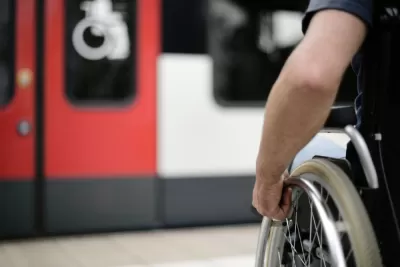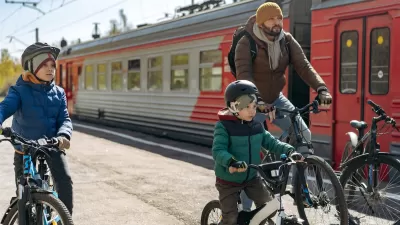Riders with disabilities say that vertical and horizontal gaps of as much as 7 inches between trains and platforms prevent many riders from safely entering and exiting trains.

A lawsuit filed by three disabled New York City transit riders calls on the Metropolitan Transportation Authority to close the gaps between platforms and trains that prevent many people using wheelchairs from safely accessing trains.
As Alissa Walker writes in Curbed, “The complaint argues that the MTA and the New York Transit Authority ‘have not formulated any kind of plan to address the gaps that prevent people with mobility and visual disabilities from using the subway,’ despite spending more than $100 billion on capital improvements to the system since 1982.”
While the agency has committed to installing elevators at more of its stations thanks to other recent lawsuits, repairing the vertical and horizontal gaps on platforms would make train travel safer for not just wheelchair users, but also people with visual impairments.
According to Walker, “Many transit agencies have what’s called universal-level boarding, where all train floors are completely flush with all platforms.” But “In New York, due to variables in rolling stock and station design, the MTA would have to standardize all its train platforms and train cars line by line in order to achieve this.”
The plaintiffs in the suit against MTA say that stair-free access isn’t enough to ensure universal accessibility. Other agencies are implementing temporary or permanent solutions such as retractable bridge plates, portable ramps, and universal platform doors.
FULL STORY: 7-Inch Platform Gaps Are Keeping Disabled Riders Off the Subways

Planetizen Federal Action Tracker
A weekly monitor of how Trump’s orders and actions are impacting planners and planning in America.

Congressman Proposes Bill to Rename DC Metro “Trump Train”
The Make Autorail Great Again Act would withhold federal funding to the system until the Washington Metropolitan Area Transit Authority (WMATA), rebrands as the Washington Metropolitan Authority for Greater Access (WMAGA).

DARTSpace Platform Streamlines Dallas TOD Application Process
The Dallas transit agency hopes a shorter permitting timeline will boost transit-oriented development around rail stations.

Renters Now Outnumber Homeowners in Over 200 US Suburbs
High housing costs in city centers and the new-found flexibility offered by remote work are pushing more renters to suburban areas.

The Tiny, Adorable $7,000 Car Turning Japan Onto EVs
The single seat Mibot charges from a regular plug as quickly as an iPad, and is about half the price of an average EV.

Supreme Court Ruling in Pipeline Case Guts Federal Environmental Law
The decision limits the scope of a federal law that mandates extensive environmental impact reviews of energy, infrastructure, and transportation projects.
Urban Design for Planners 1: Software Tools
This six-course series explores essential urban design concepts using open source software and equips planners with the tools they need to participate fully in the urban design process.
Planning for Universal Design
Learn the tools for implementing Universal Design in planning regulations.
Municipality of Princeton
Roanoke Valley-Alleghany Regional Commission
City of Mt Shasta
City of Camden Redevelopment Agency
City of Astoria
Transportation Research & Education Center (TREC) at Portland State University
US High Speed Rail Association
City of Camden Redevelopment Agency
Municipality of Princeton (NJ)





























